Mobile Platform Wars: AMD vs. Intel
by Jarred Walton on October 5, 2007 9:10 AM EST
Futuremark Performance
The results in the Futuremark 3DMark benchmarks are generally similar to the gaming performance results we just covered, although it appears that Intel has spent a bit more time optimizing for these tests. (Yeah, we're shocked too.) We will also include PCMark05 results as another indicator of general system performance.
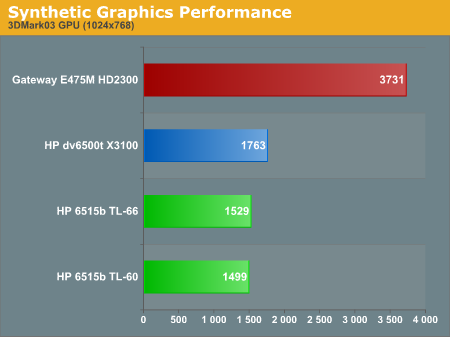
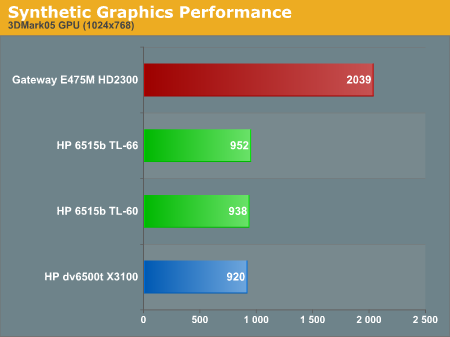
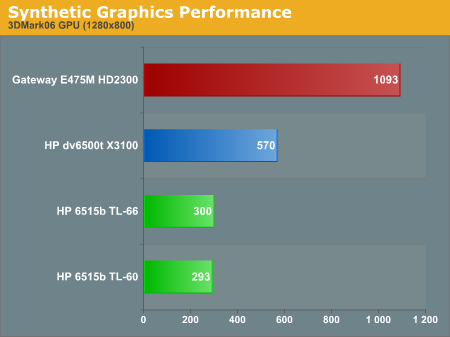
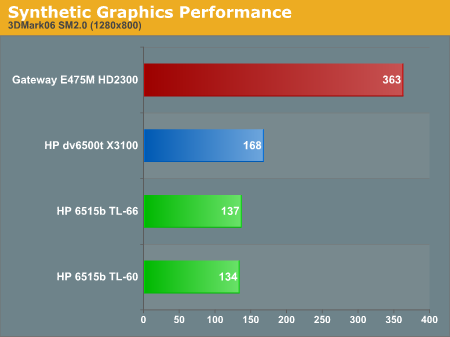
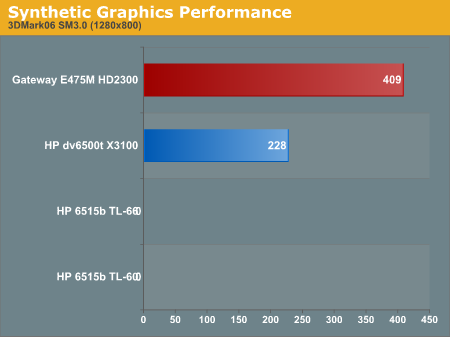
The Intel GMA X3100 system comes out in the lead in 3DMark03 and 3DMark06, while the AMD X1250 holds a small performance advantage in 3DMark05. Looking at the individual results in 3DMark06, performance is similar but the inclusion of SM3.0 support by Intel gives them a large advantage in the overall score. Meanwhile, the Radeon Mobility HD 2300 is more than twice as fast as the IGP solutions in 3DMark03/05, and very nearly so in 3DMark06.

PCMark performance shows Intel in the lead as well, but since this is more of a CPU/platform benchmark that's understandable. As usual, we've put together a table showing the individual benchmark results for PCMark05.
Some tests are closer in performance, and the hard drive in the dv6500t in particular is clearly slower than the other hard drives, but the overall advantage clearly goes to the Intel platforms. Even discounting the Gateway system that has a discrete graphics card, the faster AMD setup wins about half of the individual tests, with 2D transparency, HDD XP startup, and HDD virus scan showing the biggest differences. The dv6500t by comparison wins nine of the results, with physics and 3D, 3D pixel shaders, file decryption, 2D line redraw, file encryption, and memory latency showing larger margins of victory.
The results in the Futuremark 3DMark benchmarks are generally similar to the gaming performance results we just covered, although it appears that Intel has spent a bit more time optimizing for these tests. (Yeah, we're shocked too.) We will also include PCMark05 results as another indicator of general system performance.





The Intel GMA X3100 system comes out in the lead in 3DMark03 and 3DMark06, while the AMD X1250 holds a small performance advantage in 3DMark05. Looking at the individual results in 3DMark06, performance is similar but the inclusion of SM3.0 support by Intel gives them a large advantage in the overall score. Meanwhile, the Radeon Mobility HD 2300 is more than twice as fast as the IGP solutions in 3DMark03/05, and very nearly so in 3DMark06.

PCMark performance shows Intel in the lead as well, but since this is more of a CPU/platform benchmark that's understandable. As usual, we've put together a table showing the individual benchmark results for PCMark05.
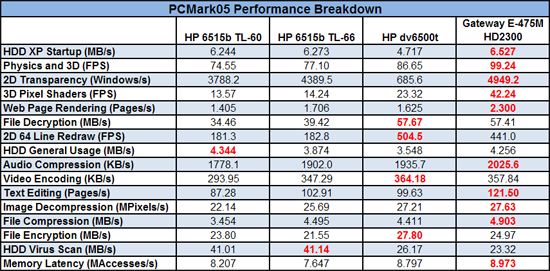 |
Some tests are closer in performance, and the hard drive in the dv6500t in particular is clearly slower than the other hard drives, but the overall advantage clearly goes to the Intel platforms. Even discounting the Gateway system that has a discrete graphics card, the faster AMD setup wins about half of the individual tests, with 2D transparency, HDD XP startup, and HDD virus scan showing the biggest differences. The dv6500t by comparison wins nine of the results, with physics and 3D, 3D pixel shaders, file decryption, 2D line redraw, file encryption, and memory latency showing larger margins of victory.










33 Comments
View All Comments
Pirks - Saturday, October 6, 2007 - link
Jarred, you wrote "Even better would be a midrange HD 2600 or GeForce 8600M/8700M, though those tend to only be found in laptops that cost over $1500" - this is totally not true. I've got myself a nice Dell Vostro 17" laptop last week, with Vista, Core 2 Duo, all the shebang... AND A REAL NVIDIA 8600M GT 256M VRAM inside, for <drumroll> $1049 </drumroll>So why don't you change your number from $1500 to $1000?
JarredWalton - Saturday, October 6, 2007 - link
There's a difference between "tend to be" and "absolutely are not available for less than..." I checked out the Vostro 1700, configured a minimum cost version with the 8600M GT 256MB, and ended up at a price of $1249. That's with a Core 2 Duo T5270 (1.4GHz 2MB cache). I'd say T7100 is a better minimum choice, and probably would look for a T7300 instead personally. That would put the price pretty darn close to $1500 ($1459 with the T7300). That's also with a current rebate to bring the price down from $1881 ($1671 minimum cost), which may not always be available.I'll take out the word "only" as it's superfluous, but I stand by the statement that most laptops with 8600M -- that aren't on sale -- will be very close to $1500 total (shipped).
BitJunkie - Friday, October 5, 2007 - link
First up, nice article.Second thing, did you notice if one system had any defining characteristics compared to each another? I've been pretty much an intel user for the last 18 months, but previously I was an AMD-holic. While P4s were about, you could notice that the UI responsiveness and load times were kind of strange for intel P4 systems compared to AMD Athlon systems - they would often be a pause or stutter on an intel system when an AMD system would just feel a lot smoother during UI operations and associated disk access. Okay, so that could have been due single core, possibly also due to cache misses and stalled pipeline on the P4, so this might be a useless braindump.....but a quick throw away comment in response to this post as to whether the architechtural differences translate in to a different feel when you're driving a system would be cool...even if it's to tell me to get a grip :)
JarredWalton - Friday, October 5, 2007 - link
Generally speaking, both laptops perform fine in Windows Vista. Without running stress tests or benchmarks, only the exterior would really let people know the difference. Interesting to note is that the Intel setup gets a 3.5 Windows Experience score while the AMD gets a 3.0, with the low score on both coming in the graphics department. Apparently, the lack of SM3.0 limits the AMD setup to a maximum score of 3.0 (the same score I get with an X800 desktop system).The bigger differences are in the styling and keyboard layout. Obviously, being a business laptop the 6515b is pretty boring looking. Honestly, though, I didn't mind that part. The dv6500t does come with better speakers as well as two headphone jacks. I think the display on the 6515b might look a bit nicer, but neither LCD is all that great. If I were to choose, though?
dv6500t with T7500, 8400M GS graphics, 2GB RAM, 160GB HDD, 802.11n+Bluetooth, and a 3-year warranty runs about $1350 and represents a pretty good deal. Drop to a T5250 and you get the price down to $1300. The dv6500z with identical options (8400M GS, 2GB, 160GB, 3-year) based on an AMD platform with a TL-64 comes to about $1350. You can drop the CPU down to a TL-60 to save $100. You can also ditch the 3-year extended warranty to bring either option under $1100. The dv6500t ends up at $1092 with T5250 and the dv6500z costs $1062 with a TL-60.
$30 more and the Intel platform should be about 15% faster on CPU tasks. Not enough to really notice, true, but it's also only increasing the cost by around 3%. I'll spend the $30 for sure. Maybe some other company can do Turion X2 for less, but I doubt it. CPU cost is only a small part of the whole.
duploxxx - Sunday, October 7, 2007 - link
well since you would choose from the budget systems for the more expensive systemwhy don't you first give us an idea how the raw cpu performance will differ from T7500 vs T5250 and for sure a t5250 versus tl-60.
because in that budget round on price/performance you should think twice. The tl-60 will outperform the T5250 on everything exept power consumption.
JarredWalton - Sunday, October 7, 2007 - link
No it won't - not even close. Look at the results in this article. A T7300 outperforms a TL-60 by an average of 25%! Do you know what a T7250 is? It's a T7300 with half the L2 cache, which causes a loss of 5-10% performance for Intel (so we're down to 15-20% performance advantage on average). Both will run at 2.0 GHz, and clock for clock AMD is at a disadvantage. Sorry, but your guess is way off. A Pentium Dual-Core running at 2.0GHz would basically match the AMD dual-core offerings clock for clock, but those tend to be cheaper.JarredWalton - Sunday, October 7, 2007 - link
Sorry - I apparently put "T5250" in my earlier comment when it should have been "T7250" if you didn't notice. T5250 is another $100 off the price of the laptop, and would compete more against an AMD TL-50.BitJunkie - Friday, October 5, 2007 - link
Excellent, thanks for the reply.nitrous9200 - Friday, October 5, 2007 - link
AMD is improving on it's existing products but still can't touch Intel. You've still got some more work to do, guys.Another thing, I don't like macs but when I looked at the side profile view of the HP, I really though "ugh!" It's so thick and ugly looking. The manufacturers should start working on aesthetics just a little bit.
JumpingJack - Friday, October 5, 2007 - link
Performance isn't everyting only when you are not the performance leader :) Price/performance is pretty much the ticket, how you define performance may vary, but in mobile that is usually a convolution of computational prowess and battery life.
I am sure if, or when, Intel no longer holds the performance "heavyweight belt", then Intel will be the one who claims performance isn't everything and AMD will be droning home what performance is all about.